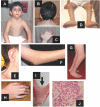Mutations in the embryonal subunit of the acetylcholine receptor (CHRNG) cause lethal and Escobar variants of multiple pterygium syndrome
- PMID: 16826531
- PMCID: PMC1559492
- DOI: 10.1086/506256
Mutations in the embryonal subunit of the acetylcholine receptor (CHRNG) cause lethal and Escobar variants of multiple pterygium syndrome
Abstract
Multiple pterygium syndromes (MPSs) comprise a group of multiple-congenital-anomaly disorders characterized by webbing (pterygia) of the neck, elbows, and/or knees and joint contractures (arthrogryposis). In addition, a variety of developmental defects (e.g., vertebral anomalies) may occur. MPSs are phenotypically and genetically heterogeneous but are traditionally divided into prenatally lethal and nonlethal (Escobar) types. To elucidate the pathogenesis of MPS, we undertook a genomewide linkage scan of a large consanguineous family and mapped a locus to 2q36-37. We then identified germline-inactivating mutations in the embryonal acetylcholine receptor gamma subunit (CHRNG) in families with both lethal and nonlethal MPSs. These findings extend the role of acetylcholine receptor dysfunction in human disease and provide new insights into the pathogenesis and management of fetal akinesia syndromes.
Figures




Similar articles
-
Mutation analysis of CHRNA1, CHRNB1, CHRND, and RAPSN genes in multiple pterygium syndrome/fetal akinesia patients.Am J Hum Genet. 2008 Jan;82(1):222-7. doi: 10.1016/j.ajhg.2007.09.016. Am J Hum Genet. 2008. PMID: 18179903 Free PMC article.
-
CHRNG genotype-phenotype correlations in the multiple pterygium syndromes.J Med Genet. 2012 Jan;49(1):21-6. doi: 10.1136/jmedgenet-2011-100378. J Med Genet. 2012. PMID: 22167768
-
Molecular Diagnosis of Rare Autosomal Recessive Escobar Syndrome in a Consanguineous Pakistani Family.Genet Test Mol Biomarkers. 2018 Dec;22(12):714-718. doi: 10.1089/gtmb.2018.0122. Epub 2018 Nov 21. Genet Test Mol Biomarkers. 2018. PMID: 30461311
-
Prenatal diagnosis and genetic analysis of fetal akinesia deformation sequence and multiple pterygium syndrome associated with neuromuscular junction disorders: a review.Taiwan J Obstet Gynecol. 2012 Mar;51(1):12-7. doi: 10.1016/j.tjog.2012.01.004. Taiwan J Obstet Gynecol. 2012. PMID: 22482962 Review.
-
CHRNG-related nonlethal multiple pterygium syndrome: Muscle imaging pattern and clinical, histopathological, and molecular genetic findings.Am J Med Genet A. 2019 Jun;179(6):915-926. doi: 10.1002/ajmg.a.61122. Epub 2019 Mar 14. Am J Med Genet A. 2019. PMID: 30868735 Review.
Cited by
-
Cleft palate is caused by CNS dysfunction in Gad1 and Viaat knockout mice.PLoS One. 2010 Mar 19;5(3):e9758. doi: 10.1371/journal.pone.0009758. PLoS One. 2010. PMID: 20333300 Free PMC article.
-
A pathogenic mechanism associated with myopathies and structural birth defects involves TPM2-directed myogenesis.JCI Insight. 2022 Jun 22;7(12):e152466. doi: 10.1172/jci.insight.152466. JCI Insight. 2022. PMID: 35579956 Free PMC article.
-
Systematic analysis of palatal transcriptome to identify cleft palate genes within TGFβ3-knockout mice alleles: RNA-Seq analysis of TGFβ3 Mice.BMC Genomics. 2013 Feb 20;14:113. doi: 10.1186/1471-2164-14-113. BMC Genomics. 2013. PMID: 23421592 Free PMC article.
-
Utilization of Whole Exome Sequencing in Lethal Form of Multiple Pterygium Syndrome: Identification of Mutations in Embryonal Subunit of Acetylcholine Receptor.Int J Mol Cell Med. 2019 Fall;8(4):258-269. doi: 10.22088/IJMCM.BUMS.8.4.258. Int J Mol Cell Med. 2019. PMID: 32587836 Free PMC article.
-
Acetylcholine receptor pathway mutations explain various fetal akinesia deformation sequence disorders.Am J Hum Genet. 2008 Feb;82(2):464-76. doi: 10.1016/j.ajhg.2007.11.006. Am J Hum Genet. 2008. PMID: 18252226 Free PMC article.
References
Web Resources
-
- Ensembl Genome Browser, http://www.ensembl.org/
-
- Online Mendelian Inheritance in Man (OMIM), http://www.ncbi.nlm.nih.gov/Omim/ (for LMPS and EVMPS)
References
-
- Escobar V, Bixler D, Gleiser S, Weaver DD, Gibbs T (1978) Multiple pterygium syndrome. Am J Dis Child 123:609–611 - PubMed
Publication types
MeSH terms
Substances
Grants and funding
LinkOut - more resources
Full Text Sources
Other Literature Sources
Medical
Molecular Biology Databases

